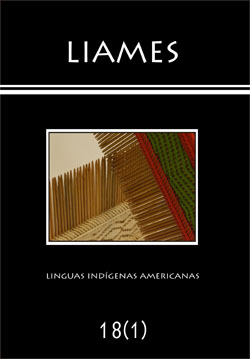Abstract
Esta presentación desarrolla, por primera vez, una discusión acerca de las nociones de Tópico y Foco en cuatro lenguas yuto-aztecas de las tierras altas del noroeste de México. Se propone que, aunque estas lenguas están genética, geográfica y culturalmente relacionadas, cuentan con estrategias distintivas para codificar al tópico y foco como elementos de la Estructura de la Información. El artículo también muestra que los elementos para codificar el tópico, pueden además marcar el foco o contribuir a la conectividad de un discurso coherente. Finalmente, se considera que las estrategias de codificación del tópico o foco pueden tener sus raíces en las prácticas retóricas lingüístico-culturales de estos pueblos.
References
Barreras Aguilar, Isabel Justina (1998). Orden de palabras básico en el guarijío de Sonora. En Cuarto Encuentro Internacional de Lingüística en el Noroeste. Memorias, Zarina Estrada-Fernández; Max Figueroa Esteva: Gerardo López Cruz; Andrés Acosta Félix. Tomo 1, Volumen 1: 37-68. Hermosillo: Editorial Unison.
Bisang, Walter (2016). Finiteness, nominalization, and information structure: Convergence and divergence. En Finiteness and nominalization, Claudine Chamoreau; Zarina Estrada-Fernández, pp. 13-41. Amsterdam: John Benjamins. doi: 10.1075/tsl.113.02bis
Bril, Isabelle (2010). Informational and referential hierarchy. Clause-linking strategies in Austronesian-Oceanic languages. En Clause Linking and Clause Hierarchy: Syntax and Pragmatics, pp. 269-311. Amsterdam: John Benjamins. doi: 10.1075/slcs.121.08bri
Burgess, Don (1984). Western Tarahumra. En Ronald W. Langacker (ed) Studies in Uto-Aztecan Grammar. Volume 4. Southern Uto-Aztecan Grammar in Grammatical Sketches, pp. 1-150. Dallas: The Summer Institute of Linguistics and The University of Arlington.
Comrie, Bernard (1998). Switch reference in Haruai: Grammar and discourse. En Mark Janse (ed.). Productivity and creativity: Studies in general and descriptive linguistics in Honor of E. M. Uhlenbeck, pp. 421-432. Berlin: Mouton de Gruyter.
Cook, Philippa; Bildhauer, Felix (2011). Annotating information structure: The case of topic. Proceedings of the workshop Beyond Semantics: Corpus-based investigation of pragmatics and discourse phenomena, 45-56. Göttingen, Germany, 23-25 February. Bochumer Linguistische Arbeitsberichte 3.
Chafe, Charles (1974). Language and consciousness. Language 50(1): 111-133. doi: 10.2307/412014
Chafe, Charles (1976). Giveness, contrastiveness, definiteness, subjects, topics and point of view. En Charles N. Li (ed.). Subject and topic, pp. 27-55. New York: Academic Press.
Dahl, Östen (2004). The growth and maintenance of linguistic complexity. Amsterdam: John Benjamins. doi: 10.1075/slcs.71
Dery, Jeruen E. (2007). Pragmatic focus and word order variation in Tagalog. Language and Linguistics 8(1): 373-404.
Dienst, Stefan (2014). A grammar of Kulina, Berlin: Mouton de Gruyter.
Elordieta, Gorka (2008). Constraints on intonational prominence of focalized constituents. En Chungmin Lee; Matthew Gordon; Daniel Büring (eds). Topic and focus. Cross-linguistic perspectives on meaning and intonation, pp. 1-22. Dordrecht: Springer.
Estrada-Fernández, Zarina. En desarrollo. Gramática de referencia del pima bajo. Vol. II.
Estrada-Fernández, Zarina (2012). Materiales de campo de tarahumara de Norogachi.
Estrada-Fernández, Zarina (2014). Gramática de referencia del pima bajo. Vol. I. Hermosillo: Universidad de Sonora.
Estrada-Fernández, Zarina (2016a). Clause-chaining and topic markers in languages from northwestern Mexico. Seminario de Complejidad Sintáctica, Hermosillo, Sonora, 14 y 15 de noviembre.
Estrada-Fernández, Zarina (2016b). Grammaticalization in Uto-Aztecan languages from northwestern Mexico. Manuscrito.
Estrada-Fernández, Zarina; Oseguera Montiel, Andrés (2015). La documentación de la tradición oral entre los pima: El diablo pelea con La luna. Indiana, vol. 32: 127-152.
Félix Armendáriz, Rolando (2010). Information structure, constituent order, and case in Warihío. En Gisella Ferraresi; Rosemarie Lühr (eds). Diachronic studies on information structure. Language acquisition and change, pp. 15-36. Berlin: De Gruyter.
Ferraresi, Gisella; Lühr, Rosemarie (2010). The role of information structure in language change: Introductory Remarks. En Gisella Ferraresi; Rosemarie Lühr (eds.). Diachronic studies on information structure. Language acquisition and change, pp. 1-13. Berlin: De Gruyter.
Firbas, Jan (1996). Exploring Vilém Mathesius’ use of the term theme. Linguistica Pragensia 5-23: 63-86.
Givón, T. (1975). Focus and the scope of assertion: some Bantu evidence. Studies in African Linguistics 6(2): 185-205.
Givón, T. (1979). On understanding grammar. New York: Academic Press.
Givón, T. (1983). Topic continuity and word order pragmatics in Ute. En Topic continuity in discourse: A quantitative cross language study, pp. 343-363. Amsterdam: John Benjamins.
Givón, T. (2005). Context as other minds. The pragmatics of sociality, cognition and communication. Amsterdam: John Benjamins. doi: 10.1075/z.130
Givón, T. (2011). Ute reference grammar. Amsterdam: John Benjamins. doi: 10.1075/clu.3
Guadalaxara, Thomas de, S. J. (1683). Compendio del Arte de la lengua de los tarahumares y guazápares. Puebla de los Ángeles: Diego Fernández de León.
Gunn Eide, Kristine (2010). Prosody, information structure and word order changes in Portuguese. En Gisella Ferraresi; Rosemarie Lühr (eds). Diachronic studies on information structure. Language acquisition and change, pp. 143-160. Berlin: De Gruyter. doi: 10.1075/la.213.14eid
Gutiérrez Bravo, Rodrigo (2008). La identificación de los tópicos y focos. Nueva Revista de Filología Hispánica, LVI, 2: 363-401.
Halliday, M. A. K. (1967). Notes on transitivity and theme in English. Part II. Journal of Linguistics 3: 199-244.
Instituto Nacional de Estadística Geografía e Información (2010). Censo de población y vivienda. México: INEGI.
Lambrecht, Knud (1994). Information structure and sentence form: Topic, focus and the mental representations of discourse referents. Cambridge: Cambridge University Press. doi: 10.1016/0378-2166(96)89193-4
Miller, Wick. R. (1996). Guarijío: gramática, textos y vocabulario. México: Universidad Nacional Autónoma de México.
Sanders, Ted J. M.; Gernsbacher, Morton Ann (2004). Accessibility in text and discourse. Discourse process 37(2): 79-89. doi: 10.1207/s15326950dp3702_1
Seiler, Hansjakov (1977). Cahuilla grammar. Banning, CA.: Malki Museum Press.
Steffel, Matthäus (1799 ms). Gramaticae linguae tarahumaricae. “Archiv Mesta Brna, file v3, Knihova Mittrovsky, Sign. A62”
Trudgill, Peter (2011). Sociolinguistic typology. Social determinants of linguistic complexity. Oxford: Oxford University Press.
Van Dijk, Teun A. (1977). Text and context. Explorations in the Semantics and Pragmatics of Discourse. London: Longmans.
The LIAMES: Línguas Indígenas Americanas uses the Creative Commons license (CC), thus preserving the integrity of the articles in an open access environment.



